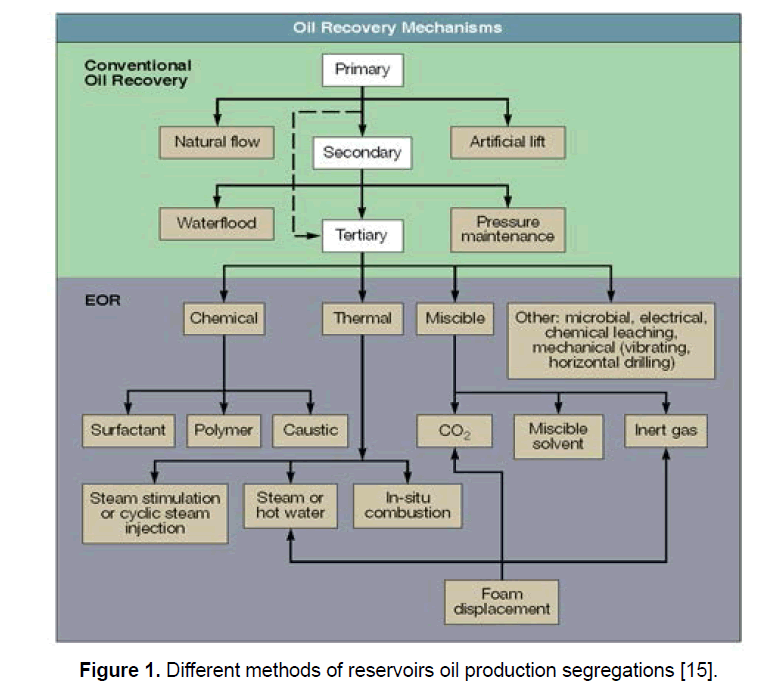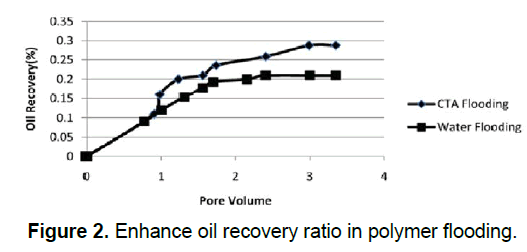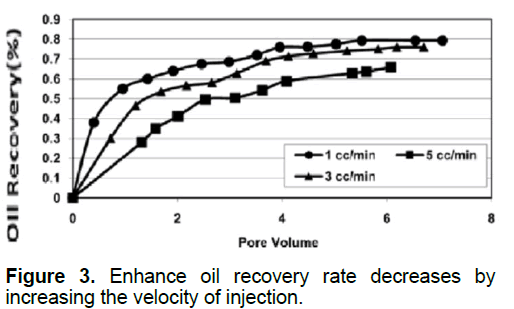Recommendations for Optimizing the Efficiency of Polymer Flooding Techniques in Production Operation of an Oilfield
Afshin Davarpanah, M Mehdi Nassabeh
1Department of Petroleum Engineering, Science and Research Branch, Islamic Azad University, Tehran, Iran
2Department of Petroleum Engineering, Faculty of Engineering and Technology, Omidiyeh Branch, Islamic Azad University, Omidiyeh, Iran
Received date: April 26, 2017; Accepted date: May 29, 2017; Published date: June 05, 2017
Citation: Davarpanah A, Nassabeh MM. Recommendations for Optimizing the Efficiency of Polymer Flooding Techniques in Production Operation of an Oilfield. Electronic J Biol, 13:3
Abstract
Thermal and chemical flooding are good alternatives to recover heavy oil. Polymer flooding procedure is one of the most important enhanced oil recovery (EOR) methodologies which improve the mobility ratio of water and oil. Adding polymer in water flooding method which involves the addition of soluble polymers in water before being injected into the reservoir, increases water viscosity even by adding a small amount of these materials. It, too, reduces the swept zone permeability and allows an increase in the vertical and areal sweep efficiency of the water injection. In this study, Polymers containing compounds of long chain such as polyacrylamide, polysaccharides, etc. leads to increase the oil movement ratio to water movement ratio. Another effect of this injection in to the reservoir is blocking the routes which have higher permeability by passing the time. As a result the water passes through these pathways are being blocked. Consequently new directions caused to increase recovery factor in the reservoir. Therefore, by increasing shear stress regarding the oil movement, the mobility will be increased.
Keywords
Polymer flooding; Mobility; Enhanced oil recovery; Sweep efficiency
1. Introduction
Enhanced oil recovery is defined as a set of techniques and processes, which is attempted to exploit and produce the amount of crude oil that is extracted by unconventional possible methods, or producing of this oil is not economical and not cost-effective. Different methods of enhanced oil recovery include: Thermal methods (stimulated cyclic steam, steam flooding, drift with hot water and in situ combustion) chemical methods (drift with polymers, surfactants, alkalis) miscible methods (injection of hydrocarbon gases, carbon dioxide and nitrogen) these methods displace oil in the reservoir from injection wells to production wells physically by increasing reservoir pressure [1-3]. Overall, the goal of all methods of enhanced oil recovery, is forcing to move the remaining oil of the reservoir in to the production well. Historically, oil production from the reservoir is divided into three phases. The early stage of production by using natural reservoir energy that is the main sources of energy for movement of oil in to production wells. These natural energy sources are gas cap drive, aquifer drive, solution gas drive, rock and fluid expansion drive and gravity segregation drive. At this stage, only about 5-30% of Original Oil in Place (OOIP) is produced. Second Stage of operation is used usually after reservoir energy reduction as a result of oil production reduction [4,5]. Secondary recovery is performed by increasing the natural reservoir energy by water or gas injection method. In this process gas and water can be used to stabilize the pressure with gas cap and aquifer expansion or immiscible oil displacement approach based on relative permeability and volumetric sweep out, which is injected into the oil field. Although water flooding has a number of benefits such as those reservoirs which are pushed by an aquifer, immiscible gas displacement method is preferred economically and it is considered as secondary recovery methods. Thus, flooding is normally equivalent in this operation classification. At the end of this stage, oil production reaches to 40-60 percent [6,7].
1.1 There are two main effects in water injection method
1. Gas is prevented from releasing in reservoir by holding the reservoir pressure above the bubble point and oil relative permeability keep up in high level.
2. Oil is pushed to production wells forward the water front [8].
At the end of this stage, due to factors that are mainly caused by poor wettability conditions, heterogeneity of reservoir rocks and oil trapped in capillary effect, a significant amount of oil (OOIP 40%-60%) remains in reservoir. To operate this amount of oil and increase ultimate recovery, EOR (Enhanced Oil Recovery) are used. Since these methods are often used after secondary methods. Also called tertiary methods of recovery [9,10]. The purpose of these methods, increase the duration of operation with strength flooding or other conventional methods that is reached to economic gain limit. Enhanced oil recovery including methods with propose of ultimate oil recovery increase by injecting materials naturally in reservoir that is not present, such as chemical materials, solvents, oxidizers and sources of heat, to create mechanisms for moving oil. By this definition of enhanced oil recovery techniques such as water and gas injection that is used to maintain reservoir pressure by using mechanical energy, also modern drilling techniques such as horizontal drilling and well stimulation does not cover in this definition [11].
Secondary and tertiary Enhanced oil recovery methods including miscible and immiscible gas injection, chemical, thermal energy or other new methods for operating more oil is of great benefit than the primary Enhanced oil recovery methods. Hydrocarbon gases, carbon dioxide, nitrogen, fuel gases, polymers, surfactants and hydrocarbon solvents are materials which are often used at this stage. Moreover, some of the thermal processes using in reservoirs are steam or hot water, heat energy generated, in-situ combustion of oil. In general tertiary recovery involves one or more injecting fluids into a reservoir. Injected Fluids and injecting techniques are complements of natural reservoir energy for replacement of oil to production wells. These fluids react with rock and oil reservoir system also to create favorable conditions for operating oil. These reactions may be favorable for example, wettability modification, or phase behavior which are connected to physical and chemical injection mechanisms or operating thermal energy [12,13].
Tertiary oil recovery methods often include more than one fluid injection. For example, relatively small amounts of expensive chemical (initial mass) are injected to moves oil. This initial mass is moved with a larger volume of chemical fluid that is relatively inexpensive (secondary mass). The secondary mass is used due to efficient displacement of initial mass with minimal loss. Sometimes other fluids are injected after secondary mass to reduce costs [14].
Different methods of reservoirs oil production Segregations are as follow in the (Figure 1) [15]:
There are many factors important during polymer flooding. For instance, critical reservoir factors that traditionally receive consideration are the reservoir lithology, stratigraphy, important heterogeneities, distribution of remaining oil and well pattern. Critical polymer properties include cost effectiveness, resistance to degradation, tolerance of reservoir salinity and hardness, retention by rock, inaccessible pore volume, rheology, and compatibility with other chemicals that might be used. Nowadays Nano particles are used for improving polymer to achieve for better polymer rheology. Use regenerated colloid particles that are in the range of about 100 nm. These solutions have also been called linked polymer solutions (LPSs) that improve the microscopic displacement efficiency in addition to the macroscopic sweep. Wang and Dong [16] show for effective viscosity of the polymer solution in porous media are a range of limitations. They showed that tertiary oil recovery improves when the effective viscosity for polymer solution was within the limitation rang. Out of the range, an increase in the effective viscosity of polymer solution resulted in very slight increase in oil recovery. Since, many tests are conducted to achieve optimal concentration of polymer for simulating model [16].
2. Methodology of Work
In fact, polymer flooding is an improved method of water injection; in addition it is the most commonly optimized chemical process. High polymer molecular weight cases to increase water viscosity and some of polymers decrease water relative permeability without oil relative permeability changing and it can improve sweep efficiency of injected water. The sweep efficiency is increased when one add the correct polymer to the water before injecting. In this time injected water is closing to production well and amount of oil remain in reservoir moreover, is produced with accosted oil in production well which the obstacle of water is flooding. Polymer flooding as an improved water flooding methods which is has many applications of enhanced oil recovery in reservoir. Polymer injection is as an EOR method which is classified in chemical injection group in reservoirs. Polymers with increase of injected water viscosity cause to control of water excitability and improve the sweep efficiency. Nowadays, hydrolyzed polyacrylamide is the most common synthetic polymer in optimal recovery of oil by using polymer flooding, which is used in field enhanced oil recovery; in addition, the producing cost of this polymer is high.
2.1 Methodology limitations
✓ Dense polymers should be used for highly viscous oils.
✓ Polymer flooding often has good results, when the polymer injection operates before water-oil ratio increases extremely in reservoir.
✓ Clay increases adsorption of polymer.
✓ Some of reservoir heterogeneities are acceptable, but large fractures makes the operations difficult. If such fractures find in reservoir it should be used continues impact techniques or gels polymer injection.
2.2 Methodology challenges
✓ Less injection ratio in comparison with water in first stage of polymer flooding has a reverse action and reduces the oil recovery factor.
✓ The polymer of acrylamide reduces viscosity extremely and destructs the materials moreover, increases salinity ratio and divalent ions percent.
✓ The price of resinous xanthine polymer is high and destructs by bacteria in addition, it has a great potential for making mass form and destruction of formation.
3. Results and Discussion
First, in order to realize the performance of used polymer, a comparison between water and polymer flooding is performed in secondary mode. According to this issue enhance oil recovery ratio in polymer flooding have about 10% increase in comparison with water injection which reflects the value of EOR in polymer process. It is shown in (Figure 2).
The effect of polymer injection velocity in secondary oil recovery mode; To investigate the effect of fluid velocity injection in oil recovery, polymer solution (100 parts per million) in three different speeds is injected in secondary injection and observes, the enhance oil recovery rate decreases by increasing the velocity of injection and the causes of this issue could be considered as fingering process in high velocity. It is shown in Figure 3.
The concentration of the polymer solution injection in secondary oil recovery mode; the effect of polymer solution concentration in enhance oil recovery of secondary mode illustrates the sweep efficiency increases by surging concentration of solution due to viscosity increase.
The injection of the polymer solution (100 parts per million) in tertiary mode; At this stage and after water flooding in secondary mode, to the extent, nothing oil releases from system by continuing water injection and polymer injection is operated in tertiary stage so, the ultimate oil recovery increases 47% to 62%.
4. Conclusion
In this research crude copolymer Trephtalic acid (CTA) is investigated for enhance oil recovery and two dimensional model (Hell–Shav) making with two flat glasses and a lace locates between them is designed moreover, the space of between them shows a prose media. This system saturating with light oil of Bibi-Hakimeh (Gachsaran-Iran) reservoir by a syringe pump and solution injection flooding of this polymer is operated with various concentrations in different speeds. The results show that the polymer in comparison with water injection can increase oil recovery about 10 to 15% lonely.
References
- Davarpanah A. (2016). Evaluation of gas injection in the horizontal wells and optimizing oil recovery factor by eclipse software. J Chromatogr Sep Tech. 7: 6.
- Pye DJ. (1964). Improved secondary recovery by control of water mobility. J Pet Tech. 321: 911-916.
- Sorbie KS. (1991). Polymer improved oil recovery, Blackie.
- Kumar M, Hoang V, Satik C, et al. (2008). High-mobility-ratio-water flood performance prediction: Challenges and new insights. SPEREE. 11: 186-196.
- Taber JJ, Seright RS. (1992). Horizontal injection and production wells for EOR, Paper SPE 23952 Presented at the SPE/DOE Symposium on Enhanced Oil Recovery, Tulsa, Oklahoma. 22-24.
- Taber JJ, Martin FD, Seright RS. (1997). EOR screening criteria revisited, Part 1: Introduction to Screening Criteria and Enhanced Recovery Field Projects. SPEREE. 12: 189-198.
- Seright RS. (1991). Effect of rheology on gel placement. SPERE. Trans AIME. 6: 212-218.
- Wang DM, Seright RS, Shao Z. (2008). Key aspects of project design for polymer flooding at the daqing oil field. SPEREE. 11: 1117-1124.
- Tormod S, Spildo K, Skauge A. (2010). Nano size particles for EOR, SPE 129933-MS. SPE improved oil recovery symposium, Tulsa, Oklahoma, USA.
- Wang J, Dong M. (2009). Optimum effective viscosity of polymer solution for improving heavy oil recovery. J Pet Sci Eng. 67: 155-158.
- Alvarado V, Manrique E. (2010). Enhanced oil recovery: An update review. J Energies. 3: 1529-1575.
- Bento HDLI. (2015). RecuperaÃÆÃâÃâçÃÆÃâÃâão avanÃÆÃâÃâçada de ÃÆÃâÃâóleo viscoso por injeÃÆÃâÃâçÃÆÃâÃâão de polÃÆÃâÃâÃÂmero em
- diferentes temperaturas. University of Campinas.
- Botechia VE, Correia MG, Schiozer DJ. (2016). A model-based production strategy selection considering polymer flooding in heavy oil field development, in: SPE energy resources conference.
- Cassinat JC, Payette MC, Taylor DB. (2002). Optimizing water flood performance by utilizing hot water injection in a high paraffin content reservoir, in: SPE improved oil recovery symposium. Society of Petroleum Engineers, Tulsa, Oklahoma, USA. 13.
- Abubaker HA. (2015). An overview of oil production stages: enhanced oil recovery techniques and nitrogen injection. Int J Env Sci Dev. 6: 9.
- Choi B, Jeong MS, Lee KS. (2014). Temperature-dependent viscosity model of HPAM Polymer through high-temperature reservoirs. Polym Degrad Stab. 110: 225-231.

Open Access Journals
- Aquaculture & Veterinary Science
- Chemistry & Chemical Sciences
- Clinical Sciences
- Engineering
- General Science
- Genetics & Molecular Biology
- Health Care & Nursing
- Immunology & Microbiology
- Materials Science
- Mathematics & Physics
- Medical Sciences
- Neurology & Psychiatry
- Oncology & Cancer Science
- Pharmaceutical Sciences



